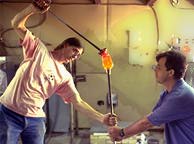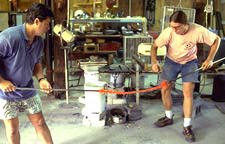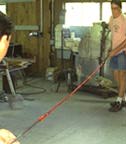|
|
||
 |
A New Twist in Neon Tubing |
|
text & photos by Jacob Fishman
|
||
| From the start we had clear tubing. The world of neon was red or blue. Soon colored tubing appeared in the form of Novial, Ruby Red, and Bromo Blue. I think the name Bromo came from the popular deep blue Bromo-Seltzer bottles, the glass color that is made with Cobalt.
The U.S. production of these colors ended during WWII however, afterwards came the advent of internal fluorescent coatings for color. Pink and Turquoise became the official colors of the fifties. By the sixties and seventies color tubing was a thing of the past. The recent resurgence in neon created a demand for more colors, distributors started to import glass tubing from overseas. Each manufacturer had different colors with different properties. Adding to the color pallet some neon shops have started coloring the outside of the tube. All of these methods of obtaining color has truly made our choice infinite, what more can there be? |
||
| Recently I had the pleasure of working with David Wilson, a glass blower working in furnace blown glass. At David's studio we made tubing for neon. Tubing that was truly spectacular just by itself. His tubing had stripes, spots, and different textures. I had tried hand pulled tubing in the past, but nothing like this. The best part was David's glass was easily workable in my neon shop fires and it was compatible to commercial tubing and electrodes. | ||
| The process starts with a hollow steel blowpipe, pre heated to a dull glow. A piece of colored glass is picked up with the pipe, worked to an even heat, and then using the hollow pipe the glass blower creates a bubble. The colored glass is dipped into a tank of molten clear glass, turned and lifted to gather more glass.
The bubble inside is enlarged and worked to be consistent. At this time the glass can be pulled into tubing or an exterior texture may be added. |
 |
|
   |
||
| A shop assistant gathers a glass post to attach to the bottle bottom. The two glass blowers can now pull the glass to it's final shape, tubing. While stretching the glass David twists the pipe adding one more dimension to the tube.
The finished tube was about 15 feet long. This was the only draw back. I didn't want to cut it to transport it! While pondering this problem, David continued to demonstrate other ways creating tubing. |
||
| Different exterior textures can be added using molds. Dropping the bottle shape into his mold produced a cross section similar to a gear with many teeth. Another variation was to put color on the outside. This color could later be selectively removed by sand blasting! I think the process I enjoyed the most was making tubing with stripes. |  |
|
| Striped tubing took a bit of preparation. First the stripe color was picked up on a punty rod. After heating, the colored glass was pulled into a thin cane about 0.25 inch. This cane is then cooled and cut into 6 inch lengths and laid out in a pre-heat oven. Next, David picked up the canes by rolling the hot glass bottle over them. Next the form is heated and the canes melt right in. The tube is then pulled as before. | ||